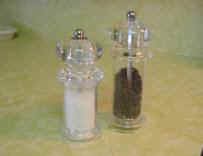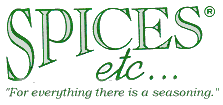Cooking Louisiana - Cajun & Creole Seasonings
|
Cajun Seasonings make Louisiana Cooking... it's the glitter in the gold! Cajun Cooking takes a great blend of readily available herbs and spices and blends them to heighten the already great flavor of your everyday foods. Your typical Cajun or Creole Louisiana cooking enthusiast has just about everything on earth in his seasoning pantry. Without these... Louisiana Style cooking wouldn't be what it is! This well stocked Cajun cooks pantry will often have herbs and spices of every age also, from "just got it yesterday" to "been having it for five years and I still don't know what to use it on". Fresh herbs and spices can be grown in beds in the garden or even rectangular containers. The ice box (refrigerator) holds a few fresh seasonings also. The quantity you should keep on hand will depend on the amount you use and/or the distance to the nearest grocery store. If you are going to try a first time dish pick up some fresh seasoning to use in it so you'll know what it really is supposed to taste like! I'm not going to get in to the difference between an herb and a spice here. In general, an herb is normally the leafy part of the plant and a spice is normally the bark or stem of a plant. The Basics: Salt, Pepper, garlic and onions. Salt comes in the box as usual, and, is also available as Sea Salt and
Kosher salt. Sea salts are usually course salts and most will
require using a salt mill. Dried Pepper types are commonly cayenne, black and white pepper. White and black peppercorns are available for grinding as are green peppercorns. Fresh ground pepper has a better flavor than pre-ground (canned). You can get a cheap mill ($5 - $7) and get some peppercorns and you're all fixed up. White, black and green peppercorns actually come from the same pepper plant, they are picked at different times and processed differently. White pepper is hotter than black and black hotter than green! White peppercorns are the fully ripened fruit followed by black (less ripe) and green (immature). Fresh peppers are good for some dishes but be careful with the heat
ranges. Several hot sauces are available especially in Louisiana, and each has it's own flavor and heat range so try a few and see which ones you like. We're seeing an explosion of pepper sauces flavored with other seasoning like garlic. I have to dispel a myth about Cajun cooking here. Cajun food is not always HOT. The typical dish is FLAVORFUL and flavorful does not always mean HOT! Pepper can be added at any time to any dish. Put the pepper on the table and let em' have at it. Garlic comes whole or minced (you know that already). Be careful not to burn garlic. You can lightly brown it but that's it. Onion varieties are yellow (most common), red (purple) and of course Vidalia. I like the Vidalia for salads or in dishes when I use big pieces and just wilt the onion They're just sweeter and have a better flavor. We could get into a big conversation about onions but it's not really necessary here, right? More essentials: Bell Pepper, Celery, Green Onions (scallions), Parsley. Most of these are in Louisiana backyard gardens. We just think of them as "the good flowers". And for heavens sake don't get caught riding your bike through the green onions. Having to cut your own switch is not the way to end the day! You can chop them and stick them in the freezer if you run into a good sale, but, they don't keep long. I prefer them fresh. Don't forget Filé which is ground leaves of Sassafras. Mostly used in Gumbos (after it's done). You can get elegant and grow your own thyme, rosemary, sweet basil and hot peppers. Many of these are available fresh at your grocer too. Bay leaves are best when they're green. I fold the bay leaf in half to break the skin before I put it in the pot. Always remove bay leaves from your dish before serving. Don't eat them. If you're lucky, you or your neighbor has their very own bay leaf tree! My deceased father planted one years ago and I still go by the old house and steal a few branches. Here's a picture of it (click here). You can buy a bay leaf tree to have your own... be ready to spend about $40. Creole and Cajun spice combinations are available by many brands. You'll have to try them and decide which ones you like. Keep in mind that for the most part they ARE different. You may choose to use one brand for one dish and another brand for some other dish. Most of them contain a lot of salt. The red coloring comes mostly from paprika not cayenne pepper. If you must eat a salt free diet you can make your own Creole Seasoning excluding the salt. Most Louisiana dishes start with onions, bell pepper and celery (the trinity). Garlic is the next and then your other seasonings. We like brown gravies which is why we either make a roux, or, brown some onions first, depends on the dish. Sometimes we do both. Stocks are also important and if they are not readily available a beef or chicken broth will do (canned or using bullion cubes). I mention this here because rouxs, browned onions and stocks are all seasonings in my book. A roux will have a slightly different flavor depending on how brown you get it. Onions will do the same. If you burn either one don't try to salvage it. Toss it out and start over. You can easily make stocks and two of the easiest are beef stock and chicken stock. Another is shrimp stock. Stocks make sauces... learn more about the old French sauces here. Andouille (ahn-doo-ee) and Taso (tah-so) are seasoning meats used by Louisiana Cooks. Each is seasoned and smoked and has each its own flavor. Andouille is a sausage with mixed ingredients. Taso is a most often a slice of ham, beef or even turkey also seasoned and smoked. With each you must be careful with amounts as they can overpower a dish. Stick to the recipe amounts until you get very familiar with them! Let's not forget "Salt Meat". This is actually salted pork, usually the picnic ham. It is uncooked and is usually heavily salted. In Houma, LA we buy the whole picnic, slice it and cut it to the size we want and freeze it. (Read more here) Oil is not thought of as a seasoning, but in my experience I look at it as one. The final outcome of a dish can depend on the type of oil you use. Don't be afraid to use combinations of oil like 2/3 vegetable oil and 1/3 olive oil. I'll sometimes take a little bacon grease or butter and add it to the vegetable oil. You just have to experiment and see what results you like best with each dish. I see many people stay completely away from saturated fats when cooking. I fully understand that these fats are bad for you. I look at it like this. I don't cook with saturated fat on a regular basis, that is, I might use bacon grease in a dish two or three times a month. Along with that let's say I make a stew using 2 tablespoons of bacon grease. I would have to eat the entire stew to ingest all of the grease. I'm sure you see where I'm going with this. In my opinion to miss out on great flavor in a special dish because you might ingest 5 drops of bacon grease is not logical to me. Do what you think is best for you. ~~~~~~~~~~~~~~~~~~~~~~~~~~~~ What to use in what? The internet is full of recipes and those recipes should be the beginning of your quest for the answer. Besides, what I like in a dish may not be what you like. Just remember to keep it simple as some dishes need little more than the basics to produce a great flavor. Cook till your heart is satisfied......
|
 Note: don't try to use
a pepper mill as a salt mill A pepper mill has a steel grinding mechanism and a salt
mill uses ceramic (non-corrosive). You can find "All
Natural" Sea Salt but it's not cheap, however it doesn't have the
processing chemicals that regular table salt contains (so they say). Kosher salt is a little courser than table
salt and chefs like it because of the ease of handling with the fingers.
Note: don't try to use
a pepper mill as a salt mill A pepper mill has a steel grinding mechanism and a salt
mill uses ceramic (non-corrosive). You can find "All
Natural" Sea Salt but it's not cheap, however it doesn't have the
processing chemicals that regular table salt contains (so they say). Kosher salt is a little courser than table
salt and chefs like it because of the ease of handling with the fingers.
